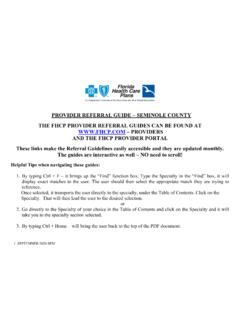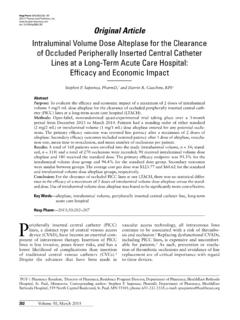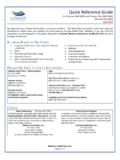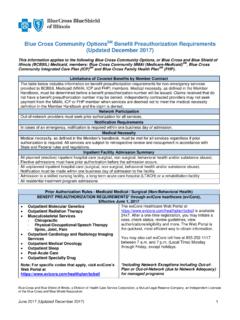Transcription of IMPACT Act for Long-Term Acute Care Hospitals - LTRAX
1 IMPACT Act for Long-Term Acute care HospitalsMary DalrympleManaging Director, LTRAXK risten Smith, MHA, PT Senior Consultant, Fleming-AODO verviewObjectives What is the IMPACT Act? Effect via LTCH Quality Reporting Program Data collection Cross-cutting measures Future Effects Post- Acute care payment Data will follow the patient Newly Proposed Discharge Planning CoPs Discuss Preparation and Considerations for Future ChangesIMPACT ActData Capture 2014 law that called for more data, and standardized data from post- Acute care settings (LTCHs, SNFs, HHAs and IRFs) Changes across existing assessments for each setting LTCH care Data Set New quality metrics that derive the same calculations across PAC settingsPurpose Foundation to revise the post- Acute care payment system Payment based on patient, not setting Improve transitions of care for patientsIMPACT Act: How it WorksExpansion of quality reporting A barnacle on the LTCH QRP barge Uses the same assessment tool (LTCH care Data Set) or claims data Currently reporting on a subset of QRP topicsMeasure domains that are minimally required.
2 Functional status, cognitive status, and changes in both Skin integrity and changes in skin integrity Medication reconciliation Major falls Transfer of health information and care preferences Resource use (including Medicare spending per beneficiary) Discharge to community Potentially preventable readmissionsIMPACT Act: How it WorksExpansion of data sharing Patient assessments and other data follow patient through health care systems Piggybacking on LTCH care Data Set to make data standard and easier to transferStandardization domains that are minimally required: Functional status Cognitive function and mental status Medication reconciliation Special services, treatments, and interventions Medical conditions and co-morbidities ImpairmentsIMPACT Act: Changes NowStandardization of LTCH care Data Set, : Interruptions section changed to match IRF assessment B0100.
3 Comatose wording changed slightly to match SNF assessment Functional Status labels changed to align with SNF and IRF assessments Minor changes for internal consistency among LTCH care Data Set questionsIMPACT Act: MeasuresNew Quality Reporting Measures: Will be reported starting April 1, 2016, for FY2018 payment determination Barnacle on existing submission and penalty barge Data transmitted via LTCH care Data Set or claims data If not reported, reimbursement will be cut by two percentage points Identified as cross-cutting or cross-setting IMPACT Act: Pressure UlcersCross-Setting Pressure Ulcer Measure Percent of Residents or Patients with Pressure Ulcers that are New or Worsened (NQF #0678) Stage 2-4 pressure ulcers that are new or worsened Same as existing LTCH QRP measure LTACH, SNF & IRF Computed separately Different patient populations Limited comparabilityNumerator: Number of patient stays where discharge assessment indicates one or more new or worsened Stage 2-4 pressure : Number of patient stays with completeadmission and discharge assessments, excluding expired patients (complete assessments need discharge PU data and admission risk-adjustment data).
4 IMPACT Act: FallsCross-Setting Falls Application of Percent of Residents Experiencing One or More Falls with Major Injury (NQF #0674) Major injury defined as bone fracture, joint dislocation, closedhead injury with altered consciousness, or subdural hematoma LTCH, SNF & IRF Similar limitationsNumerator: Number of patient stays showing one or more falls with major : Number of patient stays with completedischarge assessments (all discharge types; complete assessments include falls data). IMPACT Act: FunctionCross-Setting Function Long-Term care Hospital Patients with an Admission and Discharge Functional Assessment and a care Plan that Addresses Function (NQF #2631) Recorded discharge goal is evidence that a care plan with a goal has been established Uses a subset of data collected for the LTCH QRP version of this measure LTCH, SNF & IRF Similar limitationsNumerator.
5 Number of patient stays showing functional assessments for each self- care and mobility activity, and at least one self- care or mobility goal Discharge functional assessments not required for unplanned and expired discharges, but those patients still counted in the measure. Denominator: Number of patient Act: FunctionCross-Setting MeasureGG0130. A. EatingB. Oral hygieneC. Toileting Sit to lyingC. Lying to sitting on side of bedD. Sit to standE. Chair/bed-to-chair transferF. Toilet transferH. Does the patient walk?I. Walk 10 feetJ. Walk 50 feet with two turnsK. Walk 150 feetQ. Does the patient use a wheelchair/scooter?R.
6 Wheel 50 feet with two turnsRR. Type of wheelchair/scooterS. Wheel 150 feetSS. Type of wheelchair/scooterLTCH QRP MeasureAll cross-setting measure items, D. Wash upper Roll left and rightBB0700. Expression of ideas and wantsBB0800. Understanding verbal CAM: Acute Onset and Fluctuating CourseC. CAM: InattentionD. CAM: Disorganized ThinkingE. CAM: Altered Level of ConsciousnessH0350. Bladder ContinenceIMPACT Act: Cross-Cutting MeasuresFuture measure domains (at minimum): Functional status, cognitive status, and changes in both Skin integrity, and changes in skin integrity Medication reconciliation Major falls Transfer of health information and care preferences Resource use (including Medicare spending per beneficiary) Discharge to community Potentially preventable readmissionsIMPACT Act: Cross-Cutting Measures2015 CMS Measures Under Consideration list: Resource Use Measures: Medicare spending per beneficiary; Potentially preventable hospital readmission rates.
7 Discharge to community (claims) Deadline Oct. 1, 2016 Medication reconciliation (claims) Deadline Oct. 1, 2018 Being actively Communicating and providing transfer of health information and care preferences Deadline Oct. 1, 2018 Process started with new Discharge Planning CoPs Functional outcomes Cognition outcomes And more ..significant research opportunity for CMSIMPACT Act: Data StandardizationStandardization domains minimally required Function Cognitive function and mental status Special services, treatments, and interventions Medical conditions and co-morbidities Impairments Other categories ..research underwayDeadline: Oct.
8 1, 2018 IMPACT Act: PatientsData Follows the Patient Expectation that assessment data will be known to the patient s family, as well as follow the patient from setting-to-setting Purpose of supporting the patient s goals, needs, and preferences Major change in focus from facility participation and reporting of aggregated data to individual patient care Interoperability Effort for consumer input on the data that should be collected and transferredDischarge Planning CoPsIMPACT Act Mandate Modify the Conditions of Participation for Hospitals (including LTCHs) related to discharge planningProposed Requirements All inpatients have a written discharge plan Current discharge planning requirements revised Specific discharge instructions for all patients Discharge Planning: Six Standards1.
9 Design: Create written policies and procedures for discharge planning process that are approved by hospital s governing body2. Applicability: All inpatients (and certain outpatients)3. Discharge Planning Process : who and when Within 24 hours of admission or registration Completed before discharge or transfer (without delaying discharge), and updated throughout to reflect changes in patient s condition Practitioner treating the patient must be involved in ongoing goals and treatment preferences in light of discharge plan Patient s caregiver to be involved in planning and informed of final planDischarge Planning: Six Standards3.
10 Discharge Planning Process Hospital must consider the availability of caregivers and community-based care , their services, and their ability to provide the necessary care Evaluate patient s current and past medical history, needs, and readmission risk Consider patient s goals and treatment preferences Hospitals must assist patients and caregivers with selecting a PAC provider by using and sharing data on IMPACT Act quality and resource use measures. PAC data must be relevant and applicable to the patient s goals of care and treatment preferences. Use currently available, publicly reported quality data until IMPACT Act public reporting finalized Ongoing review of representative sample of discharge plans, including patients readmitted within 30 daysDischarge Planning: Six Standards4.





